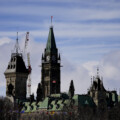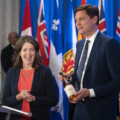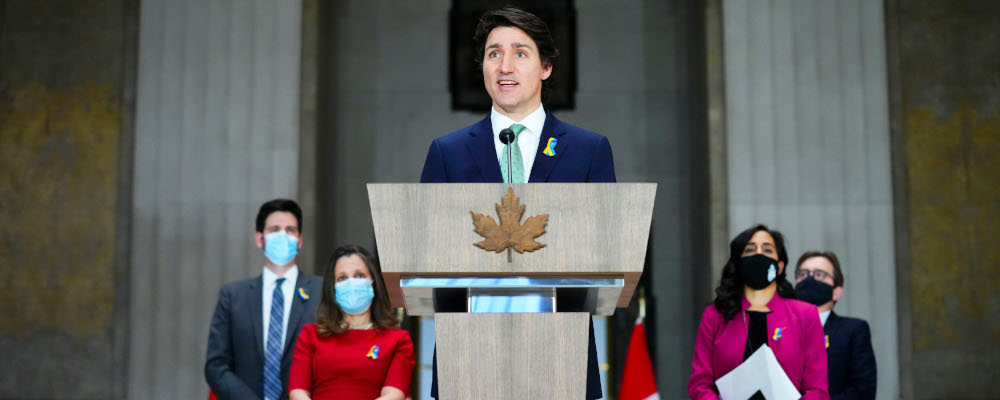Canada’s federal government got a facelift Wednesday as Prime Minister Justin Trudeau announced a major overhaul of his cabinet. Several high-profile ministers were dropped entirely, including David Lametti, Mona Fortier, and Marco Mendicino, while other notable names switched roles, including Anita Anand who has been named president of the Treasury Board, Bill Blair who takes over at defence, and Sean Fraser who moves from immigration to housing.
What does the front bench shakeup mean for the Trudeau government, and does the shuffle portend an election on the horizon? We have gathered some of The Hub’s most plugged-in contributors to offer their instant reactions and break it all down.
It’s the ideas, not the ministers, that are the real problem
By Sean Speer
Among the various possible criticisms of the Trudeau government, the weakest has always been that it lacks ambition or an agenda. Quite the contrary.
It has a strong theory of the case about the role of markets and the state and the proper goals of government policy. In particular, the prime minister and his government have pursued a clear policy agenda that’s presupposed that the conventional emphasis on economic efficiency is overstated or even wrong, that public spending to advance equity goals can itself serve as a source of economic growth, and that the biggest challenges facing the country are climate change and social exclusion rather than slow growth, poor productivity, and stagnant living standards.
The problem, in other words, has never been that the government lacks ideas. It’s that after more than seven-and-a-half years in office, its ideas have produced underwhelming results. As a rather devastating Globe and Mail editorial recently set out, the government’s track record across a range of key economic measures—including wage growth, income inequality, middle-class incomes, and GDP per capita—is worse than its predecessor’s. The editorial summed it up this way: “ [the prime minister’s] economic program has been in fact a formula for declining prosperity.”
In hindsight, such results were largely predictable. Notwithstanding the ideological arguments of some left-wing economists, there remains an important trade-off between economic efficiency and equity. Merely characterizing social spending as growth-enhancing doesn’t alter economic theory. Similarly, massive public spending and debt accumulation will eventually have inflationary effects. And ramping up immigration levels without a commensurate increase in housing supply won’t cheat the basic laws of supply and demand.
I mention this in the context of this week’s Cabinet shuffle because new and different ministers—particularly ones outside of key economic policymaking portfolios such as the department of finance or the department of industry—don’t change the government’s theory of the case. Its policies and priorities will invariably remain the same. That the rationale for many of the cabinet changes revolves around individual ministers’ “communications abilities” is itself telling. Despite the mounting evidence, the government doesn’t think its ideas are the problem.
In that sense, the cabinet shuffle is unlikely to have much effect on the government’s agenda or its political fortunes. It may change the messengers but it doesn’t change the message. That’s now part of the furniture in the building previously called Langevin Block.
The upshot: the next federal election (whenever it is held) will in large part be a referendum on whether Canadians believe that the Trudeau government’s progressive economics have made them better off or proven to be a formula for declining prosperity. Unfortunately for the government, the facts increasingly speak for themselves.
Replacing Anand in defence is a risky political gambit
By Richard Shimooka
While much of the attention given to the cabinet shuffle has focused on its scale and the demotion of high-profile names like Marco Mendicino and David Lametti, its greatest consequences will be felt within the defence portfolio with the departure of Anita Anand to the Treasury Board. She has been replaced by Bill Blair, the former minister of emergency preparedness.
Over her two years as minister, Anand has effectively governed a department in an extremely vulnerable state. On taking over the position in 2021, she was immediately forced to address multiple crises: sexual harassment, existentially poor recruitment and retention rates among the CAF personnel, growing obsolescence in the military’s capabilities, and not to mention the war in Ukraine.
Anand adroitly managed this wide variety of files and was seen as a strong and smart advocate for the military’s interests across government. She was certainly a breath of fresh air after the dysfunctional leadership of Harjit Sajjan that had allowed these problems to fester and grow in size over the five years he held the office. Yet his leadership likely better suited the prime minister’s office priorities, which tried to push defence as far off the agenda as possible in order to focus on domestic issues.
As I’ve previously written, Anand’s handling of the file had even led to some hopeful optimism about the future of Canada’s defence from many within both the department and the military. All of that is now in question, leaving personnel disappointed and fearful of what may come next.
The reasons for Anand’s departure are not clear. There are unconfirmed reports around Ottawa that she had asked out of the portfolio, spawning speculation, if true, about why she may have done so. She may have not enjoyed the file’s grind, or perhaps she harboured greater political ambitions which might be harmed by continuing on as the minister of national defence.
A more plausible possibility could be simple frustration. Her efforts to increase defence spending and approve desperately needed programs and reforms ran headlong into significant opposition within caucus. The defence policy update, the cornerstone of these rehabilitation efforts, is approximately six months delayed and there are now major questions as to whether it will ever see the light of day in its current form. Other acquisition programs, such as the P-8, as well as artillery and air defence systems necessary to support the deployment of 2,000 soldiers to Latvia, have also been thrown into doubt.
Unfortunately, Blair’s appointment as her replacement may signal a return back to the Sajjan era of leadership, where the PMO wants to spend as little attention on the department as possible. Unlike in 2015, however, this tact may not be feasible given the pressure now being directed on the government from allies and even the Canadian public. Both groups have become increasingly aware of the threadbare state of the CAF and are less willing to accept the situation. Ultimately, whatever the reasons for it, this particular shuffle may backfire on the government and become an even greater political liability if Blair cannot maintain the performance of his predecessor.
Time is of the essence on Indigenous issues
By Karen Restoule
It’s well known that governments today prioritize continuity on Indigenous portfolios given the historically challenged and untrusting Crown-Indigenous relationship. And while Patty Hajdu will remain in her ministerial post at Indigenous Services, it came as a bit of a surprise to see Gary Anandasangaree replace Marc Miller at Crown-Indigenous Relations, leaving him with very little, if no, formal contact with Indigenous Nations in his new role at immigration.
Indigenous leadership have expressed their hope that Minister Anandasangaree will follow in the footsteps of his predecessor and focus on building meaningful relationships and will continue to express eagerness to learn about Indigenous peoples.
While good relations and an enthusiasm for learning make for important political competencies generally, it’s fair to say that on anything Indigenous-related in Canada time is of the essence. Citizens remain unforgiving in our expectation that action to fulfill fiduciary obligations will be taken and bring about corrective results to long-standing core issues like clean drinking water, housing, education.
That said, there has been no indication that the shuffle will impact increasingly generous Indigenous budget allocations. While one would surmise this to tangibly affect positive change in quality of life, the Parliamentary Budget Officer found otherwise in his recent report.
This 2022 PBO Report shows that while there has been significant increases in the amount of resources allocated to Indigenous services in the past eight years, with a noted $25 billion in the last fiscal year, this has not resulted in a commensurate increase in the ability of related departments to achieve their targets. In fact, the report states their performance has declined.
Regrettably, while there’s been a shuffle, we shouldn’t expect a great deal of change
Housing may be the most important portfolio moving into the next election
By Steve Lafleur
Former immigration minister Sean Fraser will now be leading a combined housing, infrastructure, and communities portfolio. This could be good news.
There has been a near-tectonic shift in housing policy debates over the last few years. The discussion around and policy responses to declining housing affordability have been largely focused on the demand side of the market. It was fashionable to blame foreign buyers and speculators for bidding up home prices. Many measures were brought in to cool the demand side. None of them worked. So the conversation has shifted.
Outgoing minister Ahmed Hussein didn’t seem to have got the message. As of a few weeks ago he was defending municipal governments that have been reluctant to override local NIMBYs. That is out of step both with the reality of the housing market and the political winds. Politicians across the spectrum from Doug Ford to David Eby have started to focus on the supply side. The federal government needs to get on board. If not this government, the next.
Combining housing and infrastructure may be a recognition that the nexus of housing and infrastructure is precisely where the federal government has some part to play. Ever since the last election the Conservatives have been pushing to tie infrastructure funding to upzoning. It’s an idea the Liberals should absolutely steal. Maybe this is an indication that they’re heading in that direction.
The federal government has long acted as though it doesn’t have a role in the provision of market-rate housing. Hopefully, the shuffle is a sign that the feds recognize they need to start pulling supply-side levers. If they don’t, it will be a generational opportunity for the Conservative Party to capitalize on Canada’s housing malaise.

Trudeau tacitly admits his government is wounded
By Karamveer Lalh
I would describe this cabinet shuffle as a rare display of humility from this government. In bringing in a host of fresh faces, others were unceremoniously shown the door. These seven ministers have all been dropped from their positions:
- David Lametti
- Mona Fortier
- Marco Mendicino
- Joyce Murray
- Helen Jaczek
- Carolyn Bennett
- Omar Alghabra
Those ministers oversaw some of the most disastrous files for the government. Concerns around public safety and crime, affordability, and transportation are all areas where the government lost the narrative and needed a reset. This should be seen as vindication for the opposition.
It is also a rare opportunity for us to evaluate what the government itself sees as its shortcomings and where it sees its strengths. We will continue to see post-Trudeau potential leadership contenders in Joly, Freeland, Champagne, and Anand enjoy high-profile positions.
But it’s tough to say whether this shuffle will change the trajectory of this government. Our current political system is quite centralized, so a shuffle is not necessarily indicative of any policy shift. It should be a signal, however, that the government recognizes that it is wounded on those files. This overhaul is an attempt to stem the bleeding.
Recommended for You

Why giving every newborn $60,000 could be key to securing Canada’s future: Hunter Prize 2025

Canada needs a whole-of-government approach to competition policy: Hunter Prize 2025

There is no room for pacifists in the culture wars

The Weekly Wrap: Alberta is right to reform our failing health-care status quo



